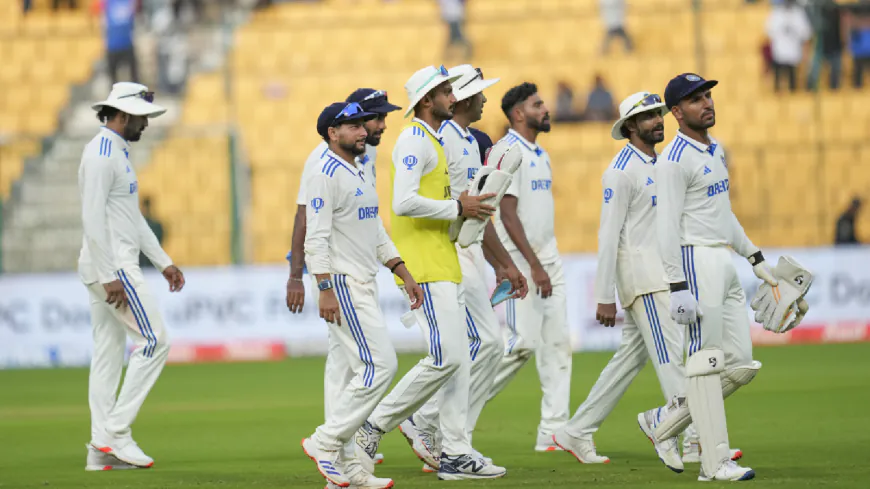India vs New Zealand: The Case for India’s Victory in the Bengaluru Test
Coaching Perspective Gambhir, who serves as the coach, highlights the importance of growth and adaptability in Test cricket. He emphasizes that teams need to evolve and not play in a monotonous style. This philosophy reflects a broader understanding of the game that values both offensive and defensive strategies. If the batting unit can effectively handle the challenges posed by New Zealand’s bowlers, the match can turn in India’s favor, especially considering their home advantage.

Despite the first day of the Test match between India and New Zealand being entirely washed out due to rain, there remains ample opportunity for India to turn the tide and secure a victory. As the groundsmen worked tirelessly to remove the drenched tarpaulin sheets covering the pitch, fans waited in hopeful anticipation, only to be met with the unfortunate news that play would not commence that day. However, the outlook is not entirely bleak, as the modern drainage system in Bengaluru holds promise for quicker recoveries from rain.
Hope in Modern Infrastructure
The advanced drainage technology in Bangalore, developed by the US-based SubAir, has proven efficient in expediting the drying of wet outfields. Capable of removing up to 10,000 liters of water per minute, this system has successfully dried the outfield in minutes during high-stakes events like the IPL and the World Cup. This gives spectators and players alike a reason for optimism, despite the initial setbacks.
The Kanpur Victory: A Fresh Memory
Adding to the optimism is the memory of India’s recent remarkable win in Kanpur. That victory has instilled confidence in the fans that India has the potential to turn around a seemingly lost cause and secure victories from dire situations. For instance, during their match against Bangladesh, India required only 173 overs—less than two full days—to clinch a win. While New Zealand may present a more formidable challenge, especially with their effective seamers thriving under cloudy conditions, history indicates that only four out of the last 19 Tests played have gone the full five days, and many ended within three days due to various weather interruptions.
Current Scenario and Future Prospects
Given these circumstances, it seems premature to worry about the possibility of a dull draw jeopardizing India’s ambitions for a third consecutive spot in the World Test Championship final. The equation is straightforward: India needs to win three out of their next eight Tests, five of which will be played in Australia. While India has the talent to win matches down under, they would prefer to secure victories at home, where they have remained undefeated in their last 18 series. Achieving a win at home would ease the pressure as they prepare for the challenging series in Australia.
A Flexible and Adaptive Team
The current weather conditions might force the Indian team to adopt a more aggressive strategy from the get-go, as hinted by captain Rohit Sharma and former cricketer Gautam Gambhir. Both have emphasized the need for adaptability in their approach, expressing a willingness to modify their game plan according to the situation. They aim to leverage every opportunity to push the game forward.
Versatile Batsmen Ready to Adapt
India’s batting lineup boasts a versatile group of players capable of executing various strategies, from aggressive batting to cautious defense. This flexibility allows them to adjust their approach based on the match situation. With players like Rohit Sharma and Ravi Ashwin in their ranks, India has a formidable core of batsmen adept at shifting gears. Their capability for aggressive stroke play was on full display during the Kanpur Test, showcasing their ability to capitalize on scoring opportunities.
If the batsmen can alternate between aggression and defense, the bowlers can do the same. The Indian bowling attack consists primarily of aggressive bowlers who are adept at both taking wickets and maintaining pressure on the batting side. Jasprit Bumrah, Mohammed Siraj, and Akash Deep are all capable of leading the attack, and each can take on the role of a strike bowler or a workhorse depending on the situation. The presence of India’s formidable spin bowlers only adds to this versatility, forming a destructive spin unit that has the potential to dismantle opposing batting orders.
Coaching Perspective
Gambhir, who serves as the coach, highlights the importance of growth and adaptability in Test cricket. He emphasizes that teams need to evolve and not play in a monotonous style. This philosophy reflects a broader understanding of the game that values both offensive and defensive strategies. If the batting unit can effectively handle the challenges posed by New Zealand’s bowlers, the match can turn in India’s favor, especially considering their home advantage.
In summary, despite the rain delays and the first day of play being called off, India possesses a realistic chance of winning the Bengaluru Test against New Zealand. The combination of a solid batting lineup that can adapt to different situations and a versatile bowling attack presents a compelling case for India's success. As long as the weather allows play to resume, India can leverage their home conditions, learn from past successes, and remain determined to secure a victory. The resilience shown by both the players and the fans alike reinforces the belief that this match could still be a memorable chapter in India's cricketing narrative. With the right mindset and execution, India can turn the situation around and keep their World Test Championship hopes alive.





















































